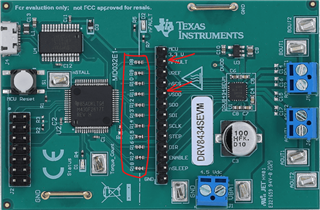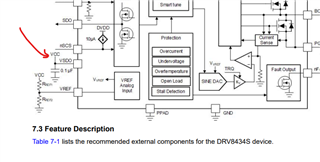Other Parts Discussed in Thread: DRV8462EVM, , DRV8434S, DRV8462
Hi,
We have recently acquired a 83434, but as of yet have been unable to get SPI to work properly, in a similar setup we used on the DRV8462EVM.
Our setup is an Arduino connected to SPI of the board, with enable and nSleep connected as well and raised high, as follows:
- SPI mode 1 and 5Mbit baud rate. We have tried other modes and other baud rates, but this one worked best on the previous stepper.
- Setup:
- 0x04 to 0x8F (default + EN_OUT=1)
- 0x07 to 0x18 (EN_STL=1)
- 0x08 to 200 - have tried many different values as well.
On the DRV8462EVM, we utilized the mode pin as well, and both pin mode (dir and step pins), and SPI step and dir via 0x05. This was successful in both setups, with various motors and various register values. In addition, on this board, SPI did not work without the board being conencted to USB as well (even though nothing is sent).
On the DRV8434SEVM, running without the USB returns nothing over SPI, while when it is connected, we consistently receive 192 on 0x00, which translates to Fault + SPI_ERROR.
What are we doing wrong? Could it be that the mode pin is incorrectly set in the board?
Thanks!
Roi







